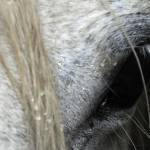Eye Injuries

Eye injuries in horses can range from minor (irritation from dust or chaff) to major (puncture wound or serious laceration). Often it’s difficult to see exactly what the problem is because the horse resists any effort to examine the injured area, which usually swells quickly after the injury. Dirt, blood, and draining fluid complicate the process of evaluating exactly what the injury is.
If you find your horse with an eye injury, resist the urge to flush the eye with water or saline solution, as this may push foreign matter further into the tissues. The veterinarian can often suture torn eyelids and prescribe medication for lacerations or irritated eyes. Don’t snip off torn tissue, as it often can be stitched into place and will heal well.
Ultrasound may be needed for a full examination of the injury. This tool has proven helpful in imaging injured structures in a noninvasive way. An external examination may miss retinal detachment, cataracts, embedded foreign objects, and adhesions that can often be detected using this technique.
Simple irritations as well as some injuries such as a scratched cornea require that medication be put into the eye several times a day. This is not as difficult as it sounds, though it’s important that it is done correctly to avoid contaminating the medication tube or causing further injury. Have the veterinarian show you how to put ointment into the eyelid or corner of the eye where it will soften and spread as the horse blinks.
Avoidance of an eye injury is far easier than treating the problem after it occurs. Follow these guidelines to minimize dangers around your barn:
- Check stalls for blunt and sharp protrusions such as bucket hooks and splinters.
- Eliminate or block narrow openings in which a horse could get its head stuck.
- Check fields for burrs, and comb burrs out of manes and tails. A shot of detangler, silicone spray, or WD-40 will make removal easier.
- Place hay nets at a height where horses won’t get tangled in them, but not so high that dust and stems will fall into the horse’s eyes as it eats hay. Feeding hay on the ground eliminates this possibility.
If a horse sustains an eye injury in spite of these precautions, call a veterinarian to evaluate and treat the problem.








